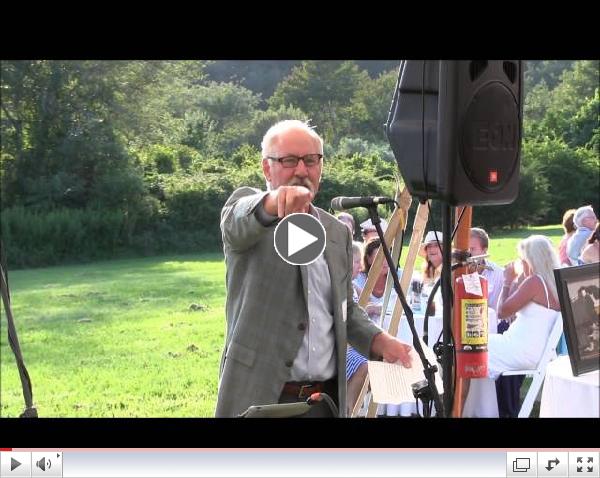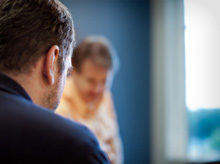|
|
Westport River Watershed Alliance
River News - September, 2014
|
|
Thanks for taking the time to check out our newsletter! It's been a busy summer here at WRWA. We thank you for your interest and your continued support.
|
One Word About Our Summer Gala
Gay Gillespie, Development Director
 | | Video courtesy of everythingwestport.com |
One word describes the full moon rising over the river the night of the Gala, the scrumptious food served up by Wilhelmina's Catering, Ten Cousins Brick Oven, The Back Eddy, Formaggio Kitchen and Wicked Kickin' Cheesecake, the music of Toph and Tom, the Live Auction hosted by Steve Fletcher, the myriad Silent Auction items beautifully displayed, the happy faces on the over 450 guests, the generosity of our hosts Ted and June Moore for loaning their beautiful property overlooking the river, the over 50 volunteers who helped with set-up, take down, decorations, parking logistics, and so much more....PERFECT.
|
|
2014 River Testing Results
Roberta Carvalho, Science Director
WRWA has been measuring bacteria levels in the River since 1991. The good news...the Westport River and its tributaries are much, much cleaner than they were ten years ago. Why? Because WRWA has been working tirelessly with the Town and local property owners to clean up our waters; unfortunately there are still times when it isn't the best idea to go swimming or boating.
 | | Summary of WRWA Bacteria Testing in 2014 |
Bacteria levels can change by the day; each week's results refer only to the morning on which the samples were taken. So what's the diagnosis? The primary message is that we continue to see elevated fecal coliform levels during wet weather events. Wet weather is defined as any day in which >0.1" of rain fell within the 48 hours preceding sample collection.
Bacteria levels are typically elevated during wet weather events, and good precautions to take include avoiding swimming right after a heavy rain. But during dry weather, bacteria levels are low enough that it's safe for swimming, boating and shellfishing (in approved areas). The big news is that 10 years ago this wasn't true.
How does fecal coliform bacteria get into streams and rivers?
Polluted water runoff from the land is the leading cause of water quality problems nationwide. Fecal material as well as other pollutants can be transported to waterways through runoff. How quickly they are transported partially depends on the type of land use. Non-developed lands including grasslands, forests and other vegetation tend to soak up rainfall, thereby increasing infiltration into the ground and reducing runoff to waterways. Developed lands such as streets, rooftops, sidewalks, parking lots, driveways, and other hard surfaces tend to create more impervious surfaces, and runoff increases. Lands that support domesticated animals, such as cattle, hogs, or horses, can also be a source of bacteria, particularly if animals enter the water for drinking or if heavy rains wash manure from the land into receiving waters.
Why test for fecal coliform bacteria?
Fecal coliforms are bacteria that live in the digestive tract of warm-blooded animals and are excreted via feces. In themselves, fecal coliforms generally do not pose a danger to people or animals but they indicate the presence of other disease-causing bacteria such as those that cause typhoid, dysentery, hepatitis, and cholera. Unlike fecal coliforms, disease causing organisms generally do not survive in the environment long enough to be detected in water. This makes their direct monitoring very complicated, expensive, and difficult. Consequently, scientists have turned to fecal coliforms as an indicator. The theory behind such a measurement follows that if a fecal contamination event is present, the source water could have been simultaneously contaminated by pathogens which can also exist in fecal material.
The presence of fecal contamination is an indicator that a potential health risk exists for individuals exposed to this water. Fecal coliform bacteria may occur in ambient water as a result of the overflow of domestic sewage or non-point sources of human and animal waste.
If high numbers of fecal coliform bacteria are found in a sample of stream water, one may conclude that there has been recent fecal contamination, although not necessarily human in origin. Other intestinal bacteria, such as streptococci or enterococci, may have a stronger correlation to human sewage, but no indicator has been identified that is exclusive to humans. The ratio of streptococci to fecal coliform was once thought to determine human versus animal fecal contamination. But, this is no longer thought to be reliable because streptococci do not persist long in an open water environment, making it difficult to assess true concentrations. Enterococcal bacteria seem to be consistently associated with human sewage and subsequent diseases, but testing for these organisms involves a lengthy and complicated procedure.
Despite the fact that they can not be linked directly to contamination by human sewage, fecal coliform bacteria counts are often used to regulate surface waters for recreational use, shellfishing, and potability (ability to be safely consumed). Federal regulations stipulate maximum allowable numbers of these bacteria for various uses. If fecal coliform counts are high (over 200 colonies per 100 ml of water sample) in the river or stream, there is a greater chance that pathogenic organisms are also present. A person swimming in such water has a greater chance of getting sick from swallowing disease-causing organisms, or from pathogens entering the body through cuts in skin, the nose, mouth, or the ears. Diseases and illnesses can be contracted in waters with high fecal coliform counts.
|
 | | Aerial view of Cockeast Pond |
What is happening in Cockeast Pond?
Betsy White, Advocacy Director
First of all, where is Cockeast Pond? It is located in the southern part of Westport just west of the harbor, and is bound by River Road on the east and Atlantic Avenue on the south. It is a salt pond, meaning it is fed by freshwater from groundwater and precipitation, and saltwater from the harbor. The saltwater comes into the pond on the flood tide and leaves on the ebb tide through a small stream which runs under River Road through a cement pipe, or culvert. This tidal exchange is important to the health of the pond and the animals and plants that live in this specific type of environment, where it is not too salty and not too fresh, but just right. For example, the endangered herring use the pond as a breeding ground, as do eels and other creatures, and the pond is critical to their survival.
Tidal exchange is also important to the existence of Cockeast Pond itself. It is small and relatively shallow and, without the influx of saltwater, it would gradually fill in and become a wet meadow. Having it exist as a salt pond is preferred by humans and is critical for all the plants and animals found there.
Because of its modest size and lack of depth, the pond is sensitive to changes in things such as salinity and nutrients, specifically nitrogen. WRWA has been conducting water quality sampling in the pond for the past six years, and will continue to do so this year. This spring, there were alarming levels of algae in the stream that connects the pond to the harbor. Up until last year, the pond had not shown an increase in nitrogen pollution, although it is somewhat enriched. The water samples taken this summer will tell us if the nitrogen levels have risen, and by how much. However, in order to determine if the health of Cockeast Pond is becoming significantly impaired, a deeper understanding of the pond system is needed.
To address this need, WRWA proposes a study that will: (1) determine the extent of the pond's decline in water quality and overall ecological health, (2) identify the causes of such a decline, and (3) develop management recommendations for restoring and maintaining the pond's health. Research will require a wide array of measurements and sampling over 2 years. The first phase of research will begin in the fall of 2014 and continue through 2015. The cost of this phase is $28,000. The second phase of research will be conducted during 2016, with management recommendations issued at the end of 2016. The estimated cost of this second phase is $30,000. A final report and presentation will be provided to all stakeholders upon completion of the study. The Coastal Systems Program at the School for Marine Science and Technology-UMass Dartmouth (CSP-SMAST) will provide technical management, data collection, and analysis, while WRWA will provide outreach and support.WRWA is currently seeking financial support for the project.
For more information regarding this project, please contact Betsy at b.white@wrwa.com or call 508-636-3016.
|
|
WRWA Summer Programs - Learning and Loving the River
The Westport River Watershed Alliance hosted our 17th year of summer science programs. The sessions teach about the importance of the Westport River and all of the creatures that call the River home. This year we reached over 100 participants from ages 3-16. Participants had a chance to discover the plants of the dunes, local shellfish, flounder, puffer fish, squid and more throughout the 8 weeks of summer program sessions. We had a wonderful time sharing what we know about the Westport River Watershed and had a great time meeting all of our future stewards.
We send out a big thanks to the Westport Yacht Club for letting the summer programs use their indoor space during rainy days and Osprey Sea Kayak for leading our paddling programs. A sincere thanks for a great job goes out to our interns for the summer James Goodman and Brendan Cormier and to Adian Corey for volunteering. See everyone next summer.
|
It's Not Too Late to Renew
It is never too late to renew your WRWA membership. Membership dollars support the day to day activities that the WRWA staff do to protect the River and its natural resources and to educate watershed students of all ages. Please renew your membership today. YOU CAN MAKE A DIFFERENCE. Visit our website to renew online:
http://westportwatershed.org/become-a-member/
|
|
Westport Municipal Meetings - Online Viewing
Great news for those who like to know what happens at local municipal meetings.
You can watch Westport's municipal meetings on the internet by following this link:
http://westport.pegcentral.com/
|
|
 Coastsweeps - International Beach Clean Up Coastsweeps - International Beach Clean Up
Since 1987, Massachusetts volunteers have scoured beaches, river banks, and marshes to pick up trash and record information about types of trash being collected. These volunteers are part of Coastsweep, the Commonwealth's annual coastal cleanup program, organized by the Massachusetts Office of Costal Zone Management and the Urban Harbors Institute of the University of Massachusetts Boston.
This year, volunteers in Westport will be participating in a Coastsweep cleanup of Cherry & Webb (Town Beach) on Saturday, September 20 from 10A.M. to noon. Trash pickers, rubber gloves, and trash bags will be provided.
You can learn more about the Coastsweep program by visiting the Coastsweep website: www.coastsweep.umb.edu.
|
|
Many Thanks to Our Corporate Supporters
|
|
|
|
|
| |
|

|
|
Lees Oil
Service
(508) 636-8866
| |
|

|

|

| |

|
 |
|
|
|
 This Summer's Water Testing Results The purpose of the program is to provide the public with information regarding which sections of the river are safe for recreational purposes, as well as helping our organization identity, and potentially eliminate sources of pollution in the rivers. During the summer, our water quality data is published on our website.
|
|
STAY CONNECTED

|
|
|
|
|